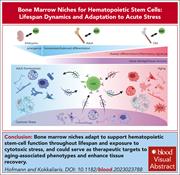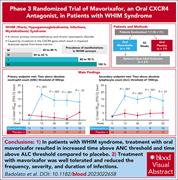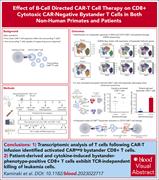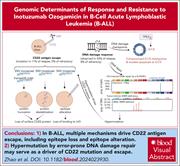Issue Archive
Table of Contents
BLOOD COMMENTARIES
SPECIAL REPORT
What clinicians should know about surrogate end points in hematologic malignancies
Clinical Trials & Observations
Surrogate end points are markers that can be measured early which correlate with long-term outcomes to allow more rapid assessment of efficacy in clinical trials. What constitutes a valid surrogate end point is not well understood by many clinicians. In this Special Report Bommier and colleagues discuss surrogate end points used in hematology/oncology clinical trials, focusing on the evidence supporting their use and recommendations on how to apply them in research and clinical practice.
REVIEW ARTICLE
Bone marrow niches for hematopoietic stem cells: life span dynamics and adaptation to acute stress
Hematopoietic stem cells (HSCs) are responsible for the production of mature blood lineages through life in steady state and in response to external stress. HSCs depend on interactions with microenvironmental niches to perform these critical roles. Hofmann and Kokkaliaris present a state-of-the-art review of how the bone marrow niche supports hematopoietic function with aging and with exposure to stress and discuss strategies for using niche-derived signals to revert aging phenotypes and improve marrow recovery after myeloablation.
CLINICAL TRIALS AND OBSERVATIONS
A phase 3 randomized trial of mavorixafor, a CXCR4 antagonist, for WHIM syndrome
Clinical Trials & Observations
Warts, hypogammaglobulinemia, infections, and myelokathexis (WHIM) syndrome is a rare, autosomal-dominant immunodeficiency usually caused by gain-of-function variants in the CXCR4 gene that leads to impaired neutrophil and lymphocyte trafficking. Plerixafor, an injectable CXCR4 inhibitor, improves cytopenias and infections in patients with WHIM syndrome. Badolato et al present a phase 3 trial of mavorixafor, an oral CXCR4 inhibitor, in 31 patients, reporting increases in peripheral counts and decreased frequency, severity, and duration of infections.
IMMUNOBIOLOGY AND IMMUNOTHERAPY
B-cell–directed CAR T-cell therapy activates CD8+ cytotoxic CARneg bystander T cells in patients and nonhuman primates
Kaminski et al examined bystander chimeric antigen receptor (CAR)–negative T cells in nonhuman primate and patient-derived T cells following CAR T-cell therapy. The authors demonstrate a bystander CD8+ CAR-negative T-cell population that efficiently kills leukemic cells through a T-cell receptor–independent mechanism, suggesting a novel mechanism underlying the antileukemic responses induced by CAR T-cell infusion.
LYMPHOID NEOPLASIA
Genomic determinants of response and resistance to inotuzumab ozogamicin in B-cell ALL
Inotuzumab ozogamicin (InO) is an antibody-drug conjugate that delivers calicheamicin to CD22-expressing cells and is approved for treatment of B-cell acute lymphoblastic leukemia (B-ALL). Zhao and colleagues examined the genetic basis for InO resistance in a retrospective study of 85 adult patients with B-ALL treated with InO as a single agent or combined with other therapies. Genetic changes were heterogeneous, including antigen loss, reflecting acquired mutations in CD22, DNA damage compromise, and other unknown mechanisms, emphasizing the complexity of InO resistance.
Mutational and transcriptional landscape of pediatric B-cell precursor lymphoblastic lymphoma
B-cell precursor (BCP) lymphoid malignancies can present either as BCP acute lymphoblastic leukemia (BCP-ALL) or BCP lymphoblastic lymphoma (BCP-LBL). Kroeze et al define the mutational and transcriptional landscape of pediatric BCP-LBL and show that the spectrum of mutations is strikingly similar to BCP-ALL, although epigenetic mutations were more frequent in BCP-LBL than in BCP-ALL, where mutations in genes governing B-cell development predominate. The authors found that molecular data inform therapeutic decision-making in BCP-LBL.
MYELOID NEOPLASIA
Loss of the stress sensor GADD45A promotes stem cell activity and ferroptosis resistance in LGR4/HOXA9-dependent AML
The relapse of acute myeloid leukemia (AML) is largely attributable to the intrinsic resistance of leukemia stem cells (LSCs) to current therapies. Hassan et al report that the loss of growth arrest and DNA damage-inducible 45 alpha (GADD45A), a sensor of oxidative stress, promotes survival and expansion of LSCs. Loss of GADD45A engenders resistance to ferroptosis, an iron-mediated pathway to cell death caused by accumulation of reactive oxygen species, suggesting a novel pathway to target LSCs and reduce AML relapse.
PLATELETS AND THROMBOPOIESIS
Platelet-derived TGF-β1 induces functional reprogramming of myeloid-derived suppressor cells in immune thrombocytopenia
Immune thrombocytopenia is caused by the destruction of platelets arising from immune attack, and it has been considered that successful therapy results in an alteration of the immune milieu from which platelets passively benefit. Wang and colleagues suggest that platelets may play a more active role in this immune modulation through the secretion of transforming growth factor β1 (TGF-β1), leading to increased myeloid-derived suppressor cells and modulation of T-cell subsets.
LETTERS TO BLOOD
Testing for t(3;8) in MYC/BCL6-rearranged large B-cell lymphoma identifies a high-risk subgroup with inferior survival
Clinical Trials & Observations
Excess of circulating apotransferrin enhances dietary iron absorption in mice
Transferrin is the major carrier protein for iron, binding iron released from erythrophagocytic macrophages or duodenal enterocytes and delivering it to tissues; it is not thought to modulate iron absorption. Under normal conditions, up to two-thirds of the protein remains iron-free as apotransferrin (apo-Tf), which is available to bind redox-active non–transferrin-bound iron (NTBI). Tsyplenkova and colleagues injected excess apo-Tf into mice fed a high-iron diet, expecting it to blunt the increase in NTBI. Surprisingly, excess apo-Tf enhanced iron absorption and led to increased NTBI, suggesting it directly increases dietary iron absorption.
BLOOD WORK
ERRATUM
-
Cover Image
Cover Image
![issue cover]()
Injected fluorescent Alexa Fluor 647 transferrin (blue) is targeted to nonmacrophage erythroid cells in the spleen of Rosa26mT-mG/+;LysM-Cre reporter mice. Macrophages express membrane-targeted green fluorescent protein while the cell membrane of all other cells express tandem dimer Tomato (red). See the article by Tsyplenkova et al on page 117.
- PDF Icon Front MatterFront Matter
- PDF Icon Table of ContentsTable of Contents
- PDF Icon Editorial BoardEditorial Board
Advertisement intended for health care professionals
Email alerts
Advertisement intended for health care professionals









